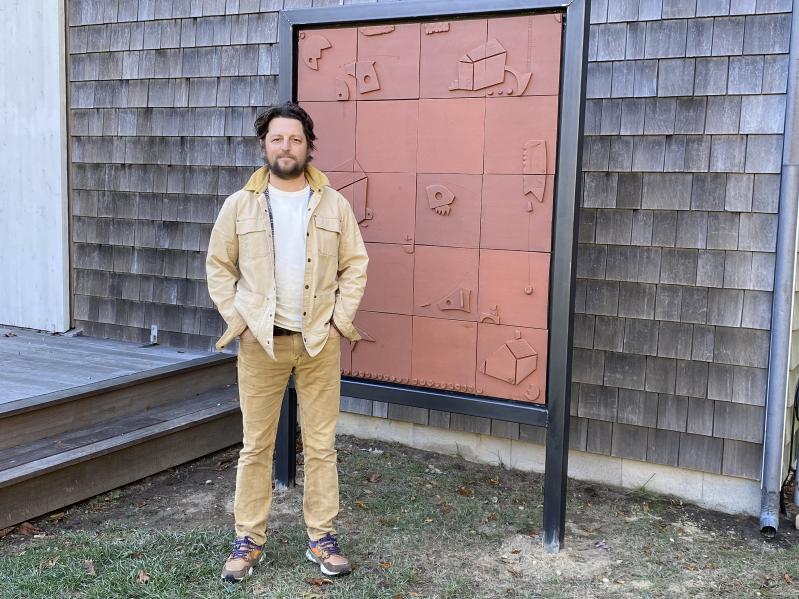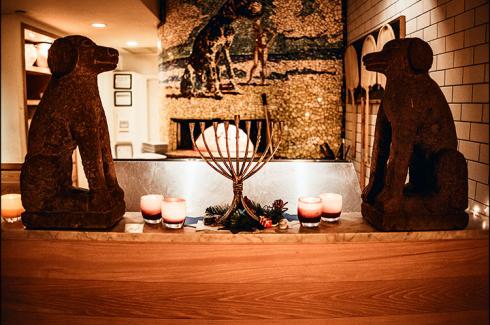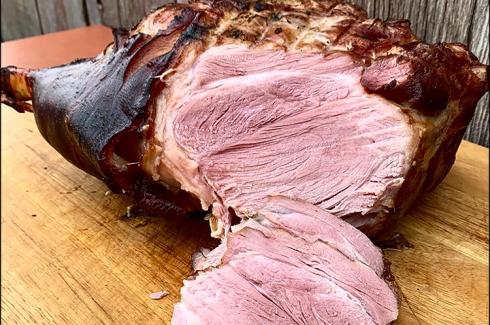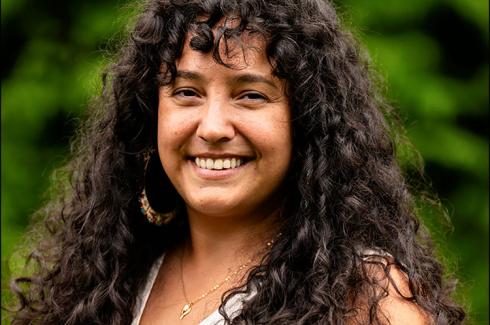Encountering Fitzhugh Karol's monumental steel sculptures on the grounds of the Arts Center at Duck Creek in Springs, it might come as a surprise to know that the career of this prolific artist began with clay. While growing up in rural New Hampshire, he drew voraciously, but it wasn't until his senior year at Deerfield Academy, a boarding school in Massachusetts, that he discovered pottery.
After Deerfield he went to Skidmore College in Saratoga Springs, N.Y. "They had an amazing ceramics program, and I really just leaned in and fell in head over heels," he said during a conversation at his studio in Springs. "By the end of my freshman year, I knew it was what I wanted to do."
While growing up in Orford, a farming town on the Connecticut River, Mr. Karol was exposed to art and culture. His godfather, Joseph Wheelwright, was a sculptor based in Boston who had a summer studio in nearby East Corinth, Vt. "We spent a lot of time with the Wheelwrights. My mom was an English teacher, but she did calligraphy in the English tradition and some painting and collage."
As for his father, after a brief career as a Wall Street lawyer, he opted for documentary filmmaking, and co-directed "Ben's Mill," a film produced for PBS that earned an Academy Award nomination for best documentary feature in 1982.
While still a freshman at Skidmore, Mr. Karol met Toshiko Takaezu, a renowned ceramic artist whose monolithic pieces were made and fired at the college. Each year she chose a student to apprentice with her, and when Mr. Karol was a senior, she invited him to do a 13-month apprenticeship after graduation.
"It was absolutely remarkable, hugely transformative, to be completely steeped in the life of an artist who had dedicated themselves 100 percent to their craft and their passion," Mr. Karol said. "She really encouraged me to keep the pedal down, don't take a break, apply to graduate school right away." He went on to earn an M.F.A. at the Rhode Island School of Design in Providence in 2007.
For many years Takaezu was a friend of Jack Lenor Larsen, the founder of LongHouse Reserve in East Hampton, and her work is amply represented in its holdings. "Toshiko had been a classmate of Jack Larsen's at Cranbrook, and she and I came out to East Hampton in the spring of 2004. I met Jack and Peter [Olsen, Larsen's partner] and stayed in LongHouse for a couple of nights. I'll always remember that experience, waking up there and walking through millions of daffodils. Now that same town has become the spiritual and physical home for our family."
That visit was the beginning of a professional friendship with LongHouse. Mr. Karol had kept in touch with Larsen after his apprenticeship, and in 2014 he was invited to make a sculpture for the garden. That piece, "What's Supposed to Be," a 75-foot-long white pine installation, featured abstract shapes inspired in part by landscapes, an enduring inspiration for the artist.
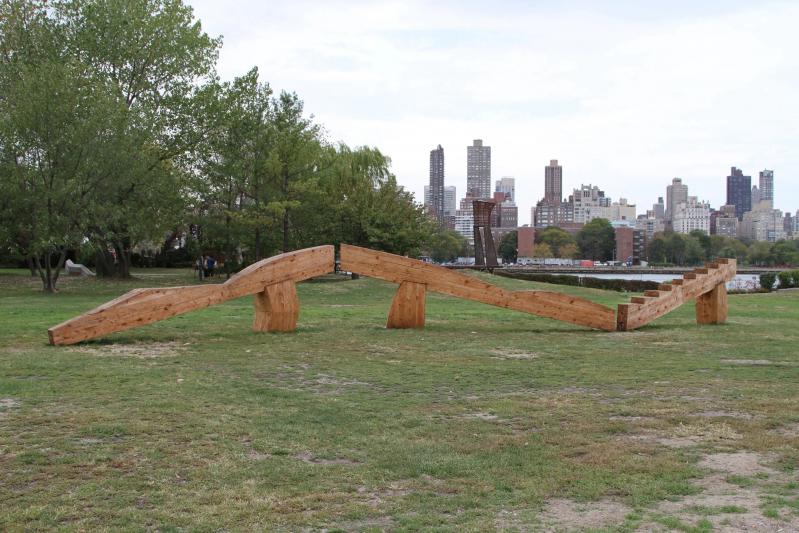
"I was beginning to execute things at a scale where people could actually interact with them, but Jack didn't want anyone climbing on anything." Later that year Mr. Karol was invited to do a piece at the Socrates Sculpture Park in Long Island City, and the result was "What's Progression," a 60-foot-long installation of carved raw hemlock timbers. "It was great, it was interactive, and kids were climbing all over it, dance companies performed, all sorts of things happened there." A turning point followed.
"Because it was made of hemlock, it was not going to last. I had this idea of doing something kind of based on that that was going to be larger, and I knew it had to be steel. I had never done any steel work, so I just jumped in and proposed a steel work to Prospect Park." He hasn't looked back.
"On the Grounds," Mr. Karol's exhibition at Duck Creek, consists of six painted steel sculptures and a ceramic relief. While giving a visitor a tour, he started with "Rabaul Hillside" (2020), an 11-foot-6-inch red piece consisting of intersecting planes, one of which has an edge that resembles sawteeth, the other a circular opening just below eye level.
"In 2018 we took a trip to Papua New Guinea. While there I was observing all these amazing volcanoes and these really spiky landscapes." Hence the sawtooth motif, which also recurs in many of his wooden reliefs and sculptures.
The large steel pieces start with thick card stock from which Mr. Karol cuts two or three planes, depending on how many planes the finished piece will be. He lays the planes flat, photographs them, and uploads the images into SketchUp, a software used in architecture, sculpture, and interior design to create and manipulate three-dimensional models.
The SketchUp model then goes to his fabricator, with whom he has created some 30 pieces. The file is enough to send the planes to the steel yard and have them cut and returned. "Then we go about stitching them together."
Two of the other pieces on the grounds, "Field's Jax I" and "Field's Jax II," both from 2018, were originally part of a piece he made a decade ago whose conjoined arch forms were 18 to 20 feet high. "When I took them down I thought, these are enormous and I'd like to make them into some smaller things."
He traced where he wanted to cut each of the arches and wound up with five planes. He made paper models of each of the pieces and they became the components of the two "Field's Jax" pieces. The blue one consists of two conjoined planes, each with a circular opening; the yellow piece is three planes, also with two holes.
The holes, whose heights and sizes vary, are an important component of all his steel sculptures. They invite the viewer to engage with the works by looking through them at the surrounding landscape as well as the other sculptures, affording a shift in perspective. Some are low enough for a limber person to climb through.
"That was a fun process, just repurposing. That's always been an interest of mine, getting information that comes from the nonintentional, meaning it wasn't preplanned. I always find a little bit of excitement from that, whether the repurposing is intentional or whether it's an accidental thing."
Mr. Karol has continued to work in wood and clay. Unlike the elongated wooden works from 2014, most of the more recent pieces, including "Friendship," which was installed at LongHouse in 2022, are totemic, and many have the stair-step sawtooth shapes.
The totems, he said, "are a little bit of their own lane. I think the interest in that format comes from the artwork of Northern peoples." It's not surprising considering that one of his uncles, William Fitzhugh, is director of the Arctic Studies Center at the Smithsonian Institution as well as a senior scientist at the National Museum of Natural History. "His publications were around the house growing up and presented indigenous artworks and artifacts, so that's probably a big source of these works, though they still have my vernacular shapes baked in."
As for clay, when he and his family moved full time to Springs during Covid, "It seemed like a way to return to something familiar that was grounding for me at that time." While his graduate thesis at RISD featured very large three-dimensional ceramic work, his recent clay pieces are tiles or plaques that are incised before firing and combined into wall reliefs, one of which is on view at Duck Creek.
He said certain shapes from the steel pieces recur in the clay reliefs, which are "ways of telling little fantasies or stories. The work at Duck Creek is a map of the property that depicts its architecture as well as the sculptures on the grounds and the native history to the land."
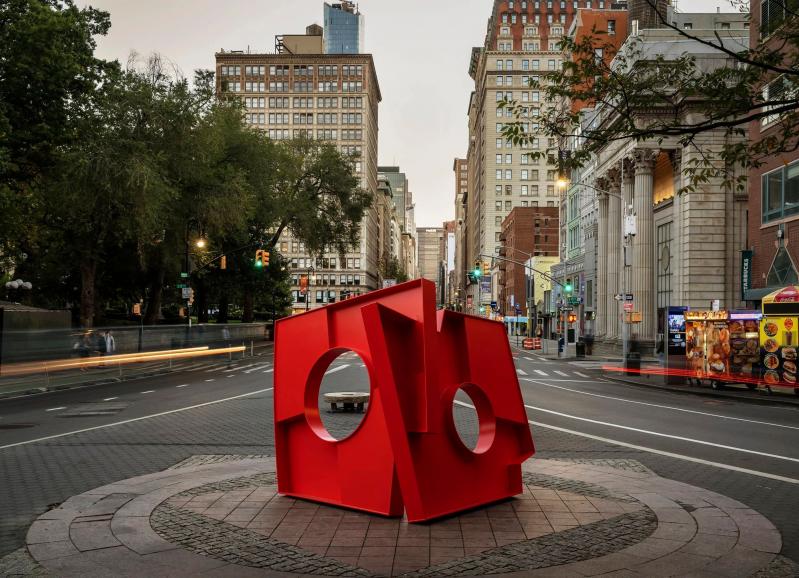
Of his steel work, he said roughly one-third are public projects being financed. One of those, "Recess: Reads," was just installed last week at Triangle Plaza in Manhattan's Union Square. Over eight feet tall, the piece consists of two red steel sections conjoined in a bifold shape, a nod to the rich literary legacy of Union Square.
"My hope is that it sparks curiosity and connection, much like the books and stories that once defined this neighborhood," Mr. Karol said in a statement on the UnionSquareNYC website. It will be officially unveiled on Nov. 19.
As for his time at RISD, it was there, while studying ceramics, that he met Lyndsay Caleo, whose field was goldsmithing. "Right from the get-go Lyndsay's ideas lit new sparks in me. She continues to inspire my processes with our dialogs and our collaborations, in both work and family." They moved to Brooklyn together after graduating in 2007 and were married in 2016. They have two children, Charlotte and Fitzhugh.
"On the Grounds" will run through Dec. 14.
This article has been modified from its original and print versions to make some corrections and clarifications.

